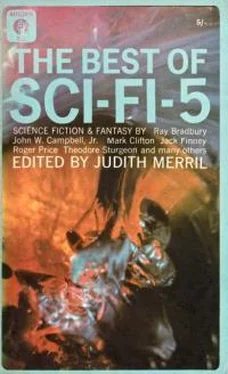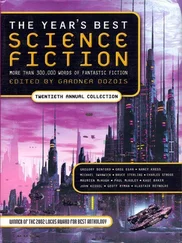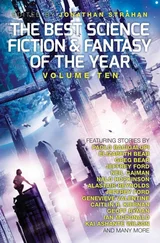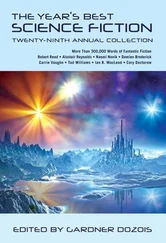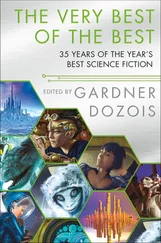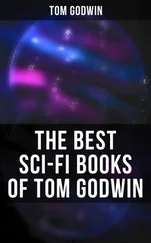The Best of Sci-Fi-5
Здесь есть возможность читать онлайн «The Best of Sci-Fi-5» весь текст электронной книги совершенно бесплатно (целиком полную версию без сокращений). В некоторых случаях можно слушать аудио, скачать через торрент в формате fb2 и присутствует краткое содержание. Год выпуска: 1966, Издательство: Mayflower-Dell, Жанр: Фантастика и фэнтези, на английском языке. Описание произведения, (предисловие) а так же отзывы посетителей доступны на портале библиотеки ЛибКат.
- Название:The Best of Sci-Fi-5
- Автор:
- Издательство:Mayflower-Dell
- Жанр:
- Год:1966
- ISBN:нет данных
- Рейтинг книги:3 / 5. Голосов: 1
-
Избранное:Добавить в избранное
- Отзывы:
-
Ваша оценка:
- 60
- 1
- 2
- 3
- 4
- 5
The Best of Sci-Fi-5: краткое содержание, описание и аннотация
Предлагаем к чтению аннотацию, описание, краткое содержание или предисловие (зависит от того, что написал сам автор книги «The Best of Sci-Fi-5»). Если вы не нашли необходимую информацию о книге — напишите в комментариях, мы постараемся отыскать её.
The Best of Sci-Fi-5 — читать онлайн бесплатно полную книгу (весь текст) целиком
Ниже представлен текст книги, разбитый по страницам. Система сохранения места последней прочитанной страницы, позволяет с удобством читать онлайн бесплатно книгу «The Best of Sci-Fi-5», без необходимости каждый раз заново искать на чём Вы остановились. Поставьте закладку, и сможете в любой момент перейти на страницу, на которой закончили чтение.
Интервал:
Закладка:
THE YEAR’S S-F
A Summary
I should not like to have it thought, from my earlier comments, that I take exception to everything Kingsley Amis says. On one point at least I am very much in agreement with him, and that is the urgent need for a new name for this field.
Not to carry the sweetness and light too far—his feeling that “ ‘ Science fiction’ is every day losing some of its appropriateness as a name for science fiction,” seems to me typical of his failure to understand what science fiction is — but for quite different reasons, I do share his conclusions.
The Sunday Herald Tribune , a few weeks ago, published a longish and most favorable review which began:
“This is a curious and original and very serious book, and it will be so satisfactory to the right reader that I think a warning is in order: though the action takes place in the future, and though a space ship takes off on the final page, this should not be confused with what is usually called science fiction…What he has really written is a highly imaginative, and basically joyous, celebration of humankind’s instinct to keep going.”
The book under discussion was Walter M. Miller, Jr.’s A Canticle for Liebowitz (Lippincott, 1959), the work of a skilled, experienced, popular s-f author, first published as a series of long novelettes in Fantasy and Science Fiction.
Now “science-fiction” books by science-fiction authors are simply not reviewed seriously in the major critical outlets. (These days, they are rarely reviewed at all.) But the canny jacketeers at Lippincott have gotten around this taboo several times now by the simple expedient of not labeling their books as s-f. In this case they went a step further: the jacket flap biography explains that Mr. Miller “compromised between art and engineering by writing science-fiction, until this, his first novel.” (My italics—J.M.)
Then they took care to plaster the jacket with quotes from “respectable literary” names—all clearly “non-science-fiction” people, except the acceptable exception, Bradbury— saying, “It falls into no genre, certainly not science fiction,” and “It is not, really, a ‘futuristic’ novel.” (Plus one from old friend Amis, who says, “… a serious and imaginative novel….”)
Thus freed of the Curse of the Tag, an excellent novel became eligible for consideration on the level on which it was written—instead of the usual fast paragraph at the space-opera stand.
Well, if this is what it takes to persuade “literary” folk to read a good book and enjoy it—down with “science fiction,” sez I. Let’s have a new label. Or none at all. Who knows? That way, Sturgeon might outsell Pat Frank.
I should confess here, also, that I owe a debt of gratitude to Mr. Amis. The wildly improbable circulation figures he quotes in his book led me to get down to a long-postponed job of research on the cross-the-counter condition of health of what we still do call science fiction—and I emerged unexpectedly reassured.
Last year I reported here that the number of magazine titles in the combined fantasy and s-f fields had dropped from twenty-one to ten. As of the start of 1960, we are down two more, to eight titles—less than at any time since before the big boom of the early fifties—since 1946, to be exact. But —
Of these eight titles, six are monthlies, and two bimonthly. In 1945-46, with eight titles, there was an average of four magazines a month issued; now there are seven. In 1949, when there were also seven magazines a month on the stands, they comprised 17 titles. In the peak year for s-f magazine publishing, 1953, there were four times as many titles as now—but only twice as many magazines.
It would be easy—and gratifying—to adduce from this that the publications surviving today are the solid, sound, worthy ones: to some degree it must even be true. But to generalize from that to the notion that “science fiction is maturing” (which I keep hearing, hopefully) would be inaccurate. The reason for all these healthy-looking regular monthly magazines has virtually nothing to do with either publishers or buyers; it is the work of the distributors, who last year began putting pressure on the publishers to go monthly or quit. Two who tried to make twelve books a year pay off, failed; two others “suspended” indefinitely without trying.
There is then less cause for alarm than one might think, but small cause for joy either, in the condition of the specialty magazines. In two other fields, however, s-f is thriving: paperback books, and general fiction magazines.
For the past five years the number of paperback books in the combined fantasy and science-fiction fields has held to a remarkably steady all-time high of 70 to 80 per year. From the looks of things, it will rise sharply this year. In short, we may expect more individual paperback books than issues of magazines this year—but the fact is that for the past two or three years, p-bs have been outselling magazines in total quantity. 60,000 copies is an exceptionally good circulation for an s-f magazine these days, I understand; but very few book publishers will issue a p-b without being able to sell at least that many. The average paperback sale is probably somewhere between 90 and 100 thousand.
In the first volume of S-F, reporting on 1955, I pointed out with some pride that as many as 50 or 60 s-f stories had appeared in “slick,” quality, and other non-s-f magazines. Last year more than that number was accounted for in the “ Playboy -type” magazines alone. With what appeared in the slick and quality magazines, there were, I should estimate, upward of 200 stories (fantasy and s-f) published in non-s-f periodicals in 1959—equal to the contents of at least three more full digest-size magazines, but with circulations (in many cases) in the hundreds, instead of tens, of thousands.
Granted that most of this non-specialty material is of low quality—so far. So was most of the stuff in Amazing and Wonder in the early ‘thirties. It’s being bought by editors who don’t know the field, and often as not from writers not much better informed. (As witness: Jack Kerouac’s pretentious “City,” in Nugget .)
But it is being bought and printed. S-f—or whatever we don’t call it—is being read and enjoyed more widely than ever before.
The new popular interest in what is still best described as “science-fiction thinking” is evidenced, again, in the really enormous quantity of speculative non -fiction appearing on all sides. As with the fiction in the unfamiliar media, much of this wordage is only by courtesy of subject matter “speculative,” and when a generally thoughtful or imaginative piece does appear, it is immediately rehashed in a dozen other publications till the last drop of new-think has been squeezed out of it. But the titles alone indicate the latent interest on the part of the mass readership:
“This Is Living in 2000,” appeared in Newsweek a few months ago. The title approximates Gernsback’s old series in the Air Wonder of the ‘twenties, and the subject matter (subheadings—”Ersatz Coffee,” “Climate Control,” and “Mining the Ocean Floor”) was not much fresher to hardened old readers of s-f. To Newsweek readers it was ahead of the news. About the same time (the turn of the decade) The New York Times Magazine published “Brave World of the Year 2000,” and This Week produced a pushbutton-happy two pages called “Get Set for the Happy New Decade.” And Esquire , in its fat gold Christmas issue for 1959, included an article by David Schoenbrun called “1960: Birth of a Century,” which was as thoughtful and comprehensive a piece of extrapolative writing as one would wish to see these days.
Читать дальшеИнтервал:
Закладка:
Похожие книги на «The Best of Sci-Fi-5»
Представляем Вашему вниманию похожие книги на «The Best of Sci-Fi-5» списком для выбора. Мы отобрали схожую по названию и смыслу литературу в надежде предоставить читателям больше вариантов отыскать новые, интересные, ещё непрочитанные произведения.
Обсуждение, отзывы о книге «The Best of Sci-Fi-5» и просто собственные мнения читателей. Оставьте ваши комментарии, напишите, что Вы думаете о произведении, его смысле или главных героях. Укажите что конкретно понравилось, а что нет, и почему Вы так считаете.
